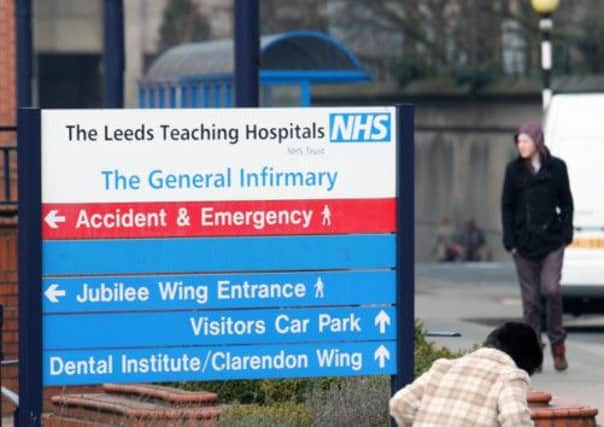Investing in staff proves right treatment for city’s A&E


It is literally at the front line of healthcare, so it’s no surprise that the situation in the accident and emergency departments of hospitals across the country has become a barometer of the health of each organisation.
As Chris Reed, interim chief executive of Leeds hospitals says in his latest report to the organisation’s directors: “A&E is the focus of so much attention in the last month it has hardly left the headlines.
Advertisement
Hide AdAdvertisement
Hide Ad“Perhaps unfairly, the perception of the public is that if you are handling A&E you are running a hospital well. But that is the accepted view of the public and therefore of politicians and commissioners in the NHS.”
In Leeds, A&E was already high on the priority list.
At the end of May, former Leeds hospitals chief executive Maggie Boyle issued an unprecedented apology to the city’s residents over waiting times at A&E departments at Leeds General Infirmary and St James’s Hospital. The apology followed months of failing to meet the national target, under which hospitals aim to treat and discharge or admit 95 per cent of patients who come into accident and emergency within four hours.
Miss Boyle said at the time: “I apologise to the people of Leeds for failing to achieve this standard and can assure them we are doing everything possible to improve the situation.”
It wasn’t only A&E where performance at Leeds Teaching Hospitals NHS Trust was not up to scratch.
Advertisement
Hide AdAdvertisement
Hide AdThe former chief executive also apologised for a failure to meet another crucial Government target over waits for planned surgery.
That says that 95 per cent of patients referred by their doctor for treatment should start it within 18 weeks.
But that was not being met for people awaiting treatment in Leeds, despite months of efforts to tackle the situation.
Her apology came after a long history of problems achieving Government targets in Leeds.
Advertisement
Hide AdAdvertisement
Hide AdOver the years, hospital bosses have struggled to ensure the trust consistently met the standards expected.
Non-executive directors sitting on the board of directors often voiced their fears that while one area was being focused on, another would slip.
Reed, who took over as temporary chief executive after the departure of Miss Boyle and will leave next month when the new chief executive takes over says: “It’s not a criticism of the past, but everyone would move around to try and get a problem solved, like waiting times – but if you have not got the right processes, information and data, it’s going to be very hard to sustain it,” he said.
Changes to staffing and attitude are the key thing which have made the difference to waiting times at A&E, according to Reed.
Advertisement
Hide AdAdvertisement
Hide AdThe four-hour target is now being hit consistently thanks to a major focus on the issue.
Mr Reed said they had looked at consultants’ shifts and the role of nurse practitioners – nurses with extra training – to fill gaps caused by a lack of middle-grade doctors, which was partly behind spiralling waiting times.
“If there’s one thing that’s made the difference in being able to achieve this target, it’s investing in more staff and looking at how they work and their contribution at different points in the patient pathway,” he added.
“That’s what’s made the difference. And probably a little bit of everybody now accepts one of the most important things we do is to see people quickly, so it’s an attitude change as well.”
Advertisement
Hide AdAdvertisement
Hide AdWith the 18-week waiting time target, Mr Reed says work to tackle a backlog is now well underway.
“Our plan is that we would achieve the 18 week target by the beginning of next year.
“We’ve got quite a bit of catching up to do in some specialties and we’ve got a path for each specialty that we’ve agreed with the Trust Development Authority over the next few months.
“We’re working as hard as we can to deliver those targets faster.”
Advertisement
Hide AdAdvertisement
Hide AdHe said hospital directors were committed to the improvements – and fully understood that behind each statistic was a patient.
“Overall I have been really impressed and delighted to be working with some of the great people in Leeds. It’s been a privilege for me to be here for a few months.”
“What lies behind the improvement this time is patient-level information that each clinical team can look at week in, week out.
“It means they are going to sustain these improvements we are going to make.
“In the past some of those systems weren’t quite right to allow that to happen.”